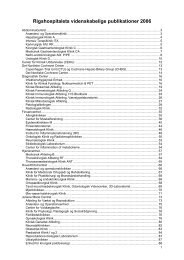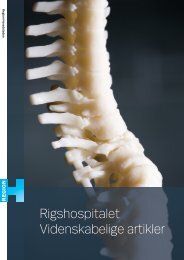View - CTU
View - CTU
View - CTU
You also want an ePaper? Increase the reach of your titles
YUMPU automatically turns print PDFs into web optimized ePapers that Google loves.
of tooth treated, the<br />
naire also asked for<br />
employment status,<br />
voted to endodontic<br />
factors in endodontic<br />
requent reason (55%<br />
es and the majority<br />
:ic injury was the only<br />
1rried out retreatment<br />
to persistent apical<br />
1.<br />
Apical I)<br />
rndiolticency<br />
"<br />
(%)<br />
0 0 3 (1)<br />
0 0 6 (1)<br />
0 61 (14)<br />
112 (25)<br />
104 (23)<br />
9~ (22)<br />
2 44 (10)<br />
0 0 16 (4)<br />
0 0 4 (1)<br />
0 1 3 (1)<br />
7 i21 5 (11 452<br />
tient and the aetiology of<br />
ission from International<br />
Treatment of deep caries in adults • an endodontic preventive strategy {Study Ill)<br />
Caries was still the major reason for performing root canal treatments in vital teeth<br />
{Study II), and it seems relevant to investigate the treatment of deep caries as an<br />
endodontic preventive strategy.<br />
The treatment of deep caries lesions represents a dilemma between initiating pulp<br />
invasive procedures or preventing endodontic treatment (Bj0rndal 2008). A deep<br />
carious lesion h.as been defined as a carious lesion where there is a risk of exposing<br />
the pulp during excavation (Fitzgerald & Heys 1991 ). Among general practitioners a<br />
deep caries lesion usually means that 75% or more of the dentin thickness is<br />
involved when examined using x-rays (Bj0rndal & Thylstrup 1998). Findings from<br />
general practice in the USA indicate that radical treatment of deep carious lesions is<br />
preferred (Oen et al. 2007). One final complete excavation is chosen as the first<br />
choice of treatment, followed by endodontic treatment (Oen et al. 2007). Older<br />
studies have shown that the removal of carious dentin using a single excavation in<br />
the primary dentition leads to exposure in about half of the cases (Magnusson &<br />
Sundell 1977). A stepwise excavation of young permanent teeth performed during<br />
two visits seems to lead to fewer pulp exposures (Leksell et al. 1996) than direct<br />
complete excavation. A less invasive stepwise excavation approach in adults has<br />
shown that the caries progression is reduced as evidenced by a decrease of the<br />
cultivable microbial flora, and clinically demonstrated by a darker, dryer and harder<br />
surface of the retained carious dentin (Bj0rndal et al. 1997, Orhan et al. 2008). A<br />
Cochrane review of caries excavation concluded that partial caries removal is<br />
preferable to complete caries removal in terms of risk for pulp exposure (Ricketts et<br />
al. 2006). However, none of the reviewed trials included well-defined deep lesions in<br />
permanent teeth in adults. In three of the trials the material comprised primary teeth<br />
(Magnusson & Sundell 1977, Ribeiro et al. 1999) or young permanent molars (Leksell<br />
et al. 1996). They also comprised different or not well-defined lesion sizes, probably<br />
because the actual aim in two of the trials was related to the quality of the<br />
restorations (Mertz-Fairhurst et al. 1998, Ribeiro et al. 1999). With only four included<br />
trials in the above mentioned Cochrane review, with a high risk of bias, there is a<br />
need to carry out new randomized clinical trials (Ricketts et al. 2006, Kidd et al.<br />
15








